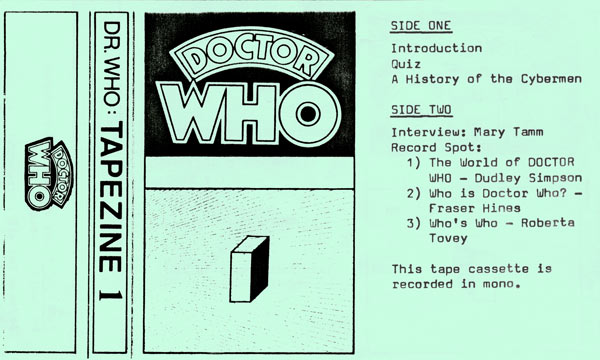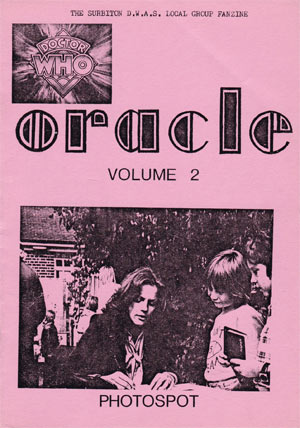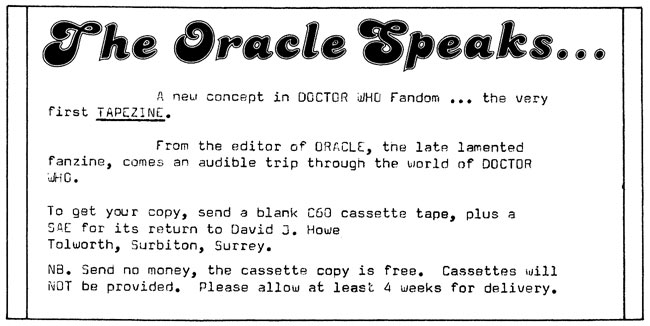|


Image © David J. Howe, 1983
|
The Basics |
|
Place of Origin:
Surbiton, Surrey, UK
Editor:
David J. Howe
In
Production:
1983 |
Distribution Media:
Audio Cassette
Tape Lengths:
#1-2: C-60
Issues Produced:
2 (Issue 2 produced but not released) |

By 1983, David J. Howe had
already established his credentials. He had edited one of the very first
independent Doctor Who fanzines, Oracle, which began as
The Surbiton Doctor Who Fanzine – produced to be sold at the
first-ever Doctor Who convention in August 1977 – and ran until
late 1981.
David fell in love with
Doctor Who during the Patrick Troughton era: “My earliest memories
of Who are The Evil of the Daleks (the Dalek conversion
process, the destruction of the Dalek city at the end) and The Tomb
of the Cybermen (the Cybermats, a Cyberman having his chest unit
ripped off). It was the monsters that I loved. They drew me in and made
me fascinated by the show. I also loved Lost in Space for similar
reasons, but Who was the thing which really intrigued me. I loved
behind-the-scenes stuff as well – and I wanted to work for the BBC so I
could do Doctor Who. That never happened though!
“I joined DWAS in late ’76.
I discovered the Reference Department run by J. Jeremy Bentham and
lapped up the STINFOs [STory INFOrmation sheets] particularly, loving
the detailed story breakdowns of the early adventures. This led to me
helping with the second convention in ’78 and contributing to Jeremy’s
output, penning some of the STINFOs. I was doing more and more and I
think when Jeremy decided to stand down, he looked to me as a sort of
‘natural successor’.” David duly assumed the Reference Department
organiser role from March 1980 and took the work of the department in
new and ambitious directions, beginning with Plotlines
publications, each of which detailed a complete season of Doctor Who.
Whilst running the Reference
Department, David found time to be a pioneer once more, on this occasion
by producing the first fanzine on audiotape. In doing so, he coined the
term ‘tapezine’, at least in the eyes of Doctor Who fandom. David
looks back to the genesis of Dr. Who: Tapezine: “I don’t really
remember now, but I suspect that with Oracle closed, I wanted to
do something ‘fannish’, and the idea of a ‘tape ’zine’ was appealing. I
had been recording Who off-air for several years – the first time
was for The Curse of Peladon, when my Dad wanted to watch UFO
(I think) which was on at the same time, and so he rigged up his
reel-to-reel to record off the telly. My dad recorded a lot of material
on audio – The Goons, Big Band shows as he loved the music – and
so we had all the equipment to do that. Later on, I recorded regularly
from Robot onwards, and eventually my dad rigged up a TV receiver
into his audio set-up, allowing off-air recordings with no extraneous
sound, or the usual buzz you got from a microphone recording. So, I had
a ‘background’ in audio.

Image © David J. Howe, 1979
“I think the idea came to do
a tapezine as I had an interview with Mary Tamm which Owen Tudor and I
had conducted when she visited a local fête to open it. We interviewed
her for my ’zine Oracle on the day, and the recording came out
pretty well, so I think that having that set wheels in motion. I had
also only recently acquired recordings of some of the ’60s Doctor Who
‘novelty’ singles, and, while you couldn’t use them in a print ’zine, on
audio... you could. The idea slowly formed to edit it all together and
make an audio fanzine.
“Part of the inspiration was
J. Jeremy Bentham and Gordon Blows’ DWAS
A History of Dr. Who tapes,
which presented a history of the programme with clips and narrative on
two cassettes. That was the very first time I heard clips from old
Who and it was magical! It was another spur to wanting to do
something myself.” Indeed, Dr. Who: Tapezine 1 begins with a
respectful homage to the History tapes, with David reperforming Jeremy’s
entrancing opening monologue – the words having been written by David
Whitaker.
David’s idea to produce a
fanzine on tape was revolutionary, even allowing for its predecessors,
A History of Dr. Who (1976-77) and
Vortex: A History of UNIT
(1983). These two titles had been documentaries about a single subject,
and while a fanzine on audio cassette was arguably just a step away from
both of these titles, no one had thought to try out the fanzine format
in the sound medium before David did. When it was advertised in the May
1983 issue of Celestial Toyroom, it marked the first time that
DWAS members were offered what David announced as “a new concept in
Doctor Who fandom... the very first TAPEZINE.” Perhaps confusingly,
the advert was headed “The Oracle Speaks...” and consequently some
listeners came to refer to David’s tapezine by this name. The title Dr.
Who: Tapezine appeared only on the cassette cover that accompanied
David’s tape, and not in the CT advert. The term ‘tapezine’ is also not
mentioned on the tape – David preferring “tape magazine” during
recording – suggesting that he thought of the contraction only when he
came to design the cassette’s packaging.

Image © David J. Howe, 1983
(As an aside, when Dr. Who: Tapezine was
advertised, another such project was in the works, being produced
completely independently - but interestingly, in the same English county
– Surrey), with its producers fully expecting to be the first
“audiofanzine” published.
Zero Room Audiozine, edited by John Ryan in association with his fellow West
Surrey DWAS Local Group members, ultimately debuted one month after
David’s tapezine, in June 1983.)
Interested Celestial Toyroom
readers could order Dr. Who: Tapezine 1 by sending David a C-60 cassette
and a stamped addressed envelope. “I decided not to charge for it as I
realised it had copyright stuff on it which I didn’t own. I asked people
to send me a tape onto which I copied the ’zine and an S.A.E. for me to
return it to them.”
Today, David has quite
understandably no records concerning how many orders he received, but, considering
the number of tapezine producers and contributors who claim to have
ordered or heard his tape via some more circuitous route, it has to be
marked down as a success.
Dr. Who: Tapezine Issue 1
featured an archive interview with Mary Tamm, a history of the Cybermen,
a quiz and a record spot which comprised Dudley Simpson’s The World of
Doctor Who (a suite of incidental music from the Jon Pertwee serial,
The
Mind of Evil) and two novelty singles - Who is Doctor Who? by actor
Frazer Hines and Who’s Who by Roberta Tovey, who had portrayed Susan in
the two Aaru Dr. Who films of the mid-1960s. These inclusions would
have presented many listeners with their first opportunity to hear these
tracks, which at the time were quite rare.
David signed off from Dr.
Who: Tapezine with the following announcement: “Please write and let me
know what you think of this trial issue – and any suggestions for items
for future issues are also welcome. That’s all for now. See you next
time.”
Work commenced on a second
issue, with an interview being recorded with Ray Dale, the manager of
the Blackpool Doctor Who Exhibition, during the 1983 fans’ summer trip
to the attraction. David also recorded a commentary as he walked through
the exhibition (much as Paul Chandler would later do at Longleat for
Lost in Longleat). However, in the fullness of
time, David realised that the issue was not coming together quite as he
had hoped: “It was a work in progress, not actually completed. I think I
ran out of content and ideas and it just floundered as I couldn’t think
of what to include that would be good or what I could do that would be
worthwhile.”
Even though the second issue
was abandoned, David had already – perhaps unwittingly – inspired a new
trend in Doctor Who fandom that would lead off in many interesting
directions – as did David’s own subsequent journey in fandom, writing
and publishing.

One of the headline features of Dr. Who:
Tapezine 1 was in fact recorded nearly five years prior to the
issue’s release. David J. Howe and Owen Tudor took the opportunity to
interview Mary Tamm when she made a personal appearance at the Surbiton
Eye Hospital Fête on Saturday 2nd September 1978. The interview was
initially transcribed and included in David’s Oracle fanzine
(Volume 2, Issue 1 – October 1978), with the audio recording itself
debuting on Dr. Who: Tapezine in May 1983. The transmission of
Season 16 of Doctor Who kicked off on the evening of the
interview, so Mary’s answers set the scene: “When I joined, I realised
that Tom [Baker] did a lot of ad-libbing – he changed a lot of the
scripts. That’s the way I like to work as well, so, seeing him doing
that inspired me to do it as well. In fact, the two of us actually
changed quite a lot of our scenes together. Most of what’ll go out – I
don’t know if I should be saying this, actually – is what Tom and I made
up, not what the scriptwriters made up! The character I play is defined
as an intellectual – I don’t know if that’s how it comes across.
Certainly the scripts are inconsistent because sometimes she’s written
very dim, but then the Doctor is sometimes written as very dim. We try
and make something of it. The thing is, the scripts aren’t really
written for aliens – they written as though we’re all human beings. Tom
sometimes tries to remind us both, or remind the scriptwriters, or the
directors that we are playing aliens, but the problem is, really, that
the scripts aren’t written that way. They could do a lot more with the
characters, but they are written in very human terms, so we have to play
them in human terms to a certain extent. [However,] there have been a
couple of scripts which have had me looking up in a dictionary all the
time. It’s not so much the words as the concepts, because there was one
story which we did three stories ago – The Pirate Planet – where
it was very difficult to grasp the concept. It took us about six weeks
to work out what the writer was really talking about! If you do
understand it, I think it helps, although the director kept telling us
that it didn’t matter whether we understood it or not. I always feel I
like to know what I’m talking about. It helps.”

The Tapezines in Focus section of
The Logopolitan Issue 1
(February 1984) included a review by Michael Flint of Dr. Who:
Tapezine Issue 1: “1983 was the year that saw the tapezine evolve.
The first on the market was David Howe’s Tapezine 1, which was
absolutely free [if you sent a C-60 and a stamped addressed envelope].
It even had a cover! This was a well-written and edited production with
many clips on it, mostly old, which are the ones few people have. The
most boring part is a poor tape of an interview with Mary Tamm. It
doesn’t reveal anything and most of the jokes are lost under the tape
noise, then followed by loud laughter. The rest of the tape is very good
sound quality, and I hope that Tapezine 2 is on its way. I hope
that it uses up more of the tape as well.”
As part of a feature looking at the development of
the Doctor Who tapezine in
Death Zone Issue 2, Keith Musselwhite remarked on the importance
of Dr. Who: Tapezine as the first tapezine issued, also noting
the inspiration that it had given to others. In addition, Keith
commented: “I have to say that Tapezine 1 – or Oracle –
was probably one of the best of the earlier tapezines.”

David J. Howe went on co-edit the
highly-respected Doctor Who fanzine The Frame with Stephen
James Walker and Mark Stammers, with whom he also wrote several
well-received books including Doctor Who: The Sixties, The
Seventies and The Eighties and seven volumes of The Doctor
Who Handbook for Virgin Publishing. His work for Virgin also
included I Am the Doctor (with Jon Pertwee) and Doctor Who:
Timeframe – The Illustrated History, which marked the programme’s
30th anniversary. For BBC Books, David wrote The Television Companion
(with Stephen) and Doctor Who: A Book of Monsters. David and
Stephen set up Telos
Publishing in 2000 and together they have overseen the
publication of cult TV reference works, original fiction, novellas and
tie-in adaptations by a wide variety of authors. David’s own books for
Telos include The Target Book (with Tim Neal), Howe’s
Transcendental Toybox (with Arnold T. Blumberg), The Who
Adventures: The Art and History of Virgin Publishing’s Doctor Who
Fiction and all manner of factual guides and fiction. Beyond
publishing, David has amassed over his lifetime one of the world’s most
comprehensive collections of Doctor Who merchandise.

|
DR.
WHO: TAPEZINE – ISSUE 1
May 1983, C-60
Side A:
-
Introduction by David J. Howe
-
Quiz: Identify the Monsters by David J. Howe
-
A History of the Cybermen by David J. Howe and Rosemary
Howe
Side B:
-
Interview: Mary Tamm, conducted by David J. Howe and Owen Tudor
(2.9.1978)
-
Record Spot, including
The World of Dr. Who by Dudley Simpson,
Who’s Dr. Who by Frazer Hines,
Who’s Who by Roberta Tovey
-
Quiz Answers by David J. Howe
DR.
WHO: TAPEZINE: ISSUE 2
Recorded but not completed or issued
Contents
included:
Interview: Ray Dale, manager of the Blackpool Doctor Who
Exhibition
The Blackpool Doctor Who Exhibition: A Walkthrough by David
J. Howe
Record Spot – a 1960s Doctor Who novelty record |
|



